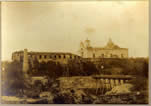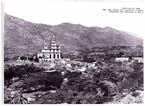 |
| |
Current Sanctuary and Basilica in El Cobre under construction, 1920s. Photograph. Cuban Heritage Collection, Richter Library, University of Miami.
  
Earlier sanctuary and hospice, El Cobre, c. 1904 (left); long distance shot of the new basilica, 1920s (center); typical view of the current sanctuary in surrounding landscape of Sierras of El Cobre, (right).
Click on images to view full size |
|
 |
< 1 >
The Sanctuary's modern building towers over this modest village with its commanding presence. The first shrine in the early 17th century was a humble hut in the top of a mountain next to a mine. The Virgin was said to have selected this location through supernatural signs--a common motif in the genre of miraculous Marian stories everywhere in the Christian world.
Since then, the shrine has been upgraded to a hermitage, several sanctuaries and in the 1920s, to the current basilica. These reconstructions have reflected the metamorphosis of this Marian tradition from a modest marginal cult to a major local, regional and later national tradition. From the late 17th century to the end of the 18th century, the shrine flourished in the midst of a black pueblo of royal slaves and free people of color. During that period its reputation as a healing shrine grew and a loose and informal local devotion became institutionalized under the aegis of the Church. By 1756, Bishop Morell de Santa Cruz declared that "The sanctuary of El Cobre is the richest, most frequented, and most devout in the Island, and the Lady of Charity the most miraculous image of all those venerated [in Cuba]."
The Sanctuary acquired national prominence during the postcolonial period, particularly after 1913, when the Church proclaimed Our Lady of Charity "patroness" of the [Christian] Cuban nation.
OF RELATED INTEREST:
El Cobre Journal: NY Times article, 2008
Slave Juan Moreno's Deposition of Apparition (and construction of first hermitages), 1687
|
